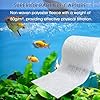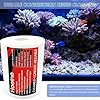How to calculate pond pump size
HiTauing 8 Pack EF-S Filter Cartridges for EF-S Element and BF5 BETTAFLO
$8.99 (as of December 21, 2025 07:21 GMT +00:00 - More infoProduct prices and availability are accurate as of the date/time indicated and are subject to change. Any price and availability information displayed on [relevant Amazon Site(s), as applicable] at the time of purchase will apply to the purchase of this product.)To get the right pump for your pond it is important to know how to calculate pond pump size among other basics.
Getting the right pump is extremely essential for maintaining the order of the natural cycles of an ecosystem. If you know how to calculate pond pump size, so you can decide whether you need the 50 gph pond pump or the 3000 gph pond pump, whichever fits perfectly into the picture of your pond.
The ideal pump assures the health of your pond, keeping it fresh and clean, as well as the lives of the fish that live inside the pond. Therefore before we jump to technical stuff like pond pump calculator for waterfalls, it is important to know as much as you can about pond pumps before you buy one.
1. TYPES OF POND PUMPS
There are two very basic types of pond pumps
- Submersible
- External
Both of them have their own application and sets of pros and cons.
Submersible Pond Pumps
As can probably be guessed from the name, these pond pumps are meant to be submerged into the pond. They are placed in the depth of the pod usually in a pond vault or a skimmer box. They can’t be placed directly onto the bottom of the pond as they might suck in dirt and break down.
Pros
- They are compact in size.
- They don’t hinder the overall beauty of the scene as they can’t be seen inside the pond.
- Their motor operates quietly without making any disturbing noises.
Cons
- They are hard to maintain as they are placed in depth.
- They are not suitable for large ponds
- They usually have low gph.
EXTERNAL PONDS
Also known as centrifugal pond pumps, these are meant to be stored on dry land. They are placed closer to the pond for better execution. They usually have greater water flow capacity.
Pros
- They are easier to maintain
- They are highly suitable for larger ponds as they have a greater gph
- They are easily maintained
- They consume less energy
Cons
- They are greater in size and can be seen in plain sight that possibly ruins the ambiance of the scene.
- They have very loud motors that make disturbing noises.
Why Do You Need a Pond Pump?
While there are many functions performed by a water pump, it all boils down to two main basic functions that are acquired: aeration and decorative.
Aeration
Some ponds are built exclusively for aeration purposes. They have higher pressure and a higher gph in order to get the oxygen circulated in the pond with a gusto. It keeps the pond fresh and healthy.
Decorative
Some pond pumps are built in order to add to the aesthetic of the pond. These pond pumps aren’t focused around the aeration function as much as they are around the visual effects that can appeal to the eyes.
They usually create different effects that please the eyes of the viewer with different patterns of the water ejection. There is a palm tree, crystalline, and many other different patterns that you can get in some water pumps.
Some waterfalls also tend to use LED lights that further enhance the appeal of the waterfall.
Decorative water pumps also have aeration quality since the water rises in the air and goes back into the pond but it is not as good as an aeration pump.
You may get a water pump that gives you both of these function as there is not a strict line between the two.
Why Getting a Water Pump is so Important?
So many things to get to know about the pond pump, is it really that important? Whether it is a 100 gph pond pump or a 10,000 gph, its importance in the cycle of a pond can’t be denied.
In the absence of a pond pump, there can be many undesired consequences that include are unhealthy for you and for the fishes living in your pond.
Water Stagnation
Without the water pump circulating the water in the pond, the water becomes stagnant. This leads to the water becoming unbearable and not the kind that you need in your pond
Deoxygenation
Without the water pump, as the water goes stagnant, the oxygen starts reducing from the water. This not only decreases the freshness of the pond but also leads to an oxygen deficit for the fishes living in the water.
Algae Growth
As the water stands stagnant, it builds up characteristics that become ideal for algae to live and grow.
Mosquito Eggs
Standing water is an ideal condition for a mosquito to lay eggs. This will not only lead for the water to be contaminated but the pond will also be filled with mosquitoes like that around the swap.
Bad Smell
Stagnant water, because of all the other things among lack of freshness and oxygen, develops a smell that is very unappealing.
Dirty Water
As the water keeps moving, the waste material keeps getting filtered through the water pump, however, in the absence of water circulation the dirt and mud build-up in the water.
Nitrate Build up
Living organisms have a nitrogen cycle, which leads to building up of nitrates that are harmful to you and the fishes in the absence of a water pump.
How to Calculate Pond Pump Size?

To be able to calculate what size pump for a 7500-liter pond, you need to know a few things that include:
- The flow rate
- The head height
- Total dynamic head
- The friction head
- The pressure head
- The max head
The Flow Rate
The most basic step in sizing up a pond pump is to calculate the flow rate. Depending on the local unit, it is usually measured in gallons per hour or liters per hour.
Head Height
After calculating the flow rate, the next step is to calculate the max head of the pump. The flow-rate is only the potential that a pump has, the real-time flow rate is determined by the quantity of the head or head height.
The head refers to the height of the water from the surface of the pump to the peak of the water gush. As the head is against the gravitational pull, the higher the height of the head, the stronger the pump in its flow.
TDH – Total Dynamic Head
Total dynamic head or TDH refers to the overall height of the pond system. This can actually be a little tricky and complicated, but as long as you keep a cool head you will get it right.
It is the calculation of the vertical distance between the surface of the water, to the peak of the pumped water in feet. It is known as the static head.
Sometimes, the total dynamic head also involves other factors like the friction head.
The Friction Head
A friction head refers to how the flow is affected by the size and the material of the pipe. In water bodies like that of a water pond, this factor does not play a very big role.
To put it simply, narrow pipes mean disrupted water flow and decreased gph while broader pipes offer less resistance that keeps the water flow high and uninterrupted.
Pressure Head
The pressure head refers to the resistance offered by the devices that are operated in pressure. This may play a role if you are to get a pod filter, spray nozzles, or a UV clarifier.
This is not very complicated to calculate. All you need is the actual pressure of the water pump and then you can estimate as per this scale: 2.31 feet = 1 psi.
After this you can put all the heads together, you will have the proper number for the pump that you need.
Max Head Height
The max head height refers to the maximum height that the water can touch. At this point, the water flow is absolutely zero as the water trickles back down.
Higher the max head, stronger the pump is.
These are all the factors that may or may not contribute to the selection of your pond pump. Following is the sizing of the pumps according to the types of different ponds.
Fountain Pump Flow Rate Calculator

As far as the fountain pump is concerned, the strength of the pump is estimated by the height the water climbs up.
You can calculate the size of the pump by following these steps:
- Calculate the diameter of the fountain outlet.
- Add 100 gph for every inch, you will have your flow rate in gph.
- Now measure the vertical height from the height at which the pump is to the outlet.
- The pump you get should be greater than this distance.
If the max head of the pump equals or is less than the vertical distance than it will fail to display its beauty and start dribbling incompetently if flow at all.
Make sure that the max head is 1.5 times greater than the vertical distance for the pump to work effectively.
Waterfall Flow Rate Calculator

Calculating the size of the waterfall pump is very much similar to the size of the fountain pump, but only a few things are done differently.
To calculate the size of the waterfall pump, you need to follow these steps.
- Calculate the distance vertically from the surface of the water to the peak of the waterfall.
- For every 10 feet of pipe that connects the pump and the pipe, add an extra one foot.
- Calculate the width of the spillway, the horizontal difference that will be covered by water as it will fall over.
- For every inch of the spillway-width add gph as per the required flow. There are three different types, trickle, sheet, and Niagara.
Add 100 gph for slow flow – the trickle
Add 150 gph for moderate flow – the sheet
Add 200 gph for faster flow – the Niagara
Fish Pond Pump Flow Rate Calculator
The factors that determine the size of the fish pond pump are the volume of the pond and the number of fish.
It is always better to go over the limit of the pond as inadequate circulation can be harmful to the fish in the pond. It is always better to go over than be short.
To Sum It All Up…
Getting a pump and the right one is extremely important for the ponds to remain fresh and healthy. There are different factors that determine the size of the pond pump as well as the type of pond that you need the pump for.




















